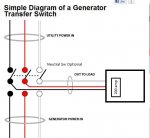chris kennedy
Senior Member
- Location
- Miami Fla.
- Occupation
- 60 yr old tool twisting electrician
Let me tell a quick story before I get to my question. I was called into the office yesterday morning to look at a problem with an ATS we installed. Guy has a 200A 1? main breaker panel. Out of this panel we installed a 2 pole 60A breaker to feed the 'Normal Power' lugs in the ATS. From the load lugs in the ATS, we install conductors back to the feed thru lugs at the bottom of the bus in the 200A panel. OK, time to test.
1) Our guy opens the 200A main breaker
2) ATS senses loss of normal power
3) ATS sends start signal, genny starts
4) Genny is up to speed and energizes bus in 200A panel
5) 60A breaker now energized on EM power
6) ATS now sees the EM power as Normal power.
7) ATS switches back to Normal power
8) Genny powers down, buss de-energizes
9) ATS senses loss of Normal power...
You get the rest, click, clack, clack, clack....
So on to my question. As I stand there in disbelief listening to these two talking about turning the 60A off here and the 200A off there and so on, one guy says, "Well if the HO did forget to turn off the main when POCO comes back on line, it will buck phases with the genny and trip the genny breaker. This is where I jump in and say that won't happen as there is no fault current path between the genny windings and POCO tranny windings. That is correct right?
In the above scenario, what would actually occur? Genny VR goes nuts, damage to POCO tranny?
Sorry for the long post but sometimes you see things that make you think, " Are you guys for real???"
1) Our guy opens the 200A main breaker
2) ATS senses loss of normal power
3) ATS sends start signal, genny starts
4) Genny is up to speed and energizes bus in 200A panel
5) 60A breaker now energized on EM power
6) ATS now sees the EM power as Normal power.
7) ATS switches back to Normal power
8) Genny powers down, buss de-energizes
9) ATS senses loss of Normal power...
You get the rest, click, clack, clack, clack....
So on to my question. As I stand there in disbelief listening to these two talking about turning the 60A off here and the 200A off there and so on, one guy says, "Well if the HO did forget to turn off the main when POCO comes back on line, it will buck phases with the genny and trip the genny breaker. This is where I jump in and say that won't happen as there is no fault current path between the genny windings and POCO tranny windings. That is correct right?
In the above scenario, what would actually occur? Genny VR goes nuts, damage to POCO tranny?
Sorry for the long post but sometimes you see things that make you think, " Are you guys for real???"
Last edited:

